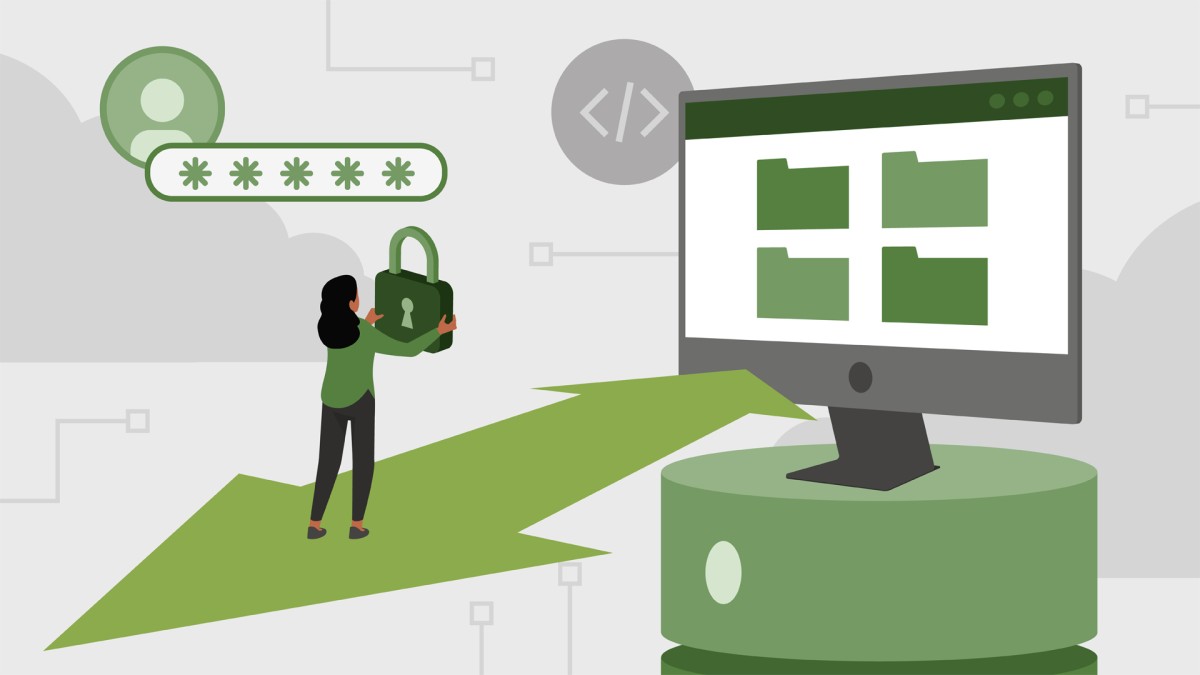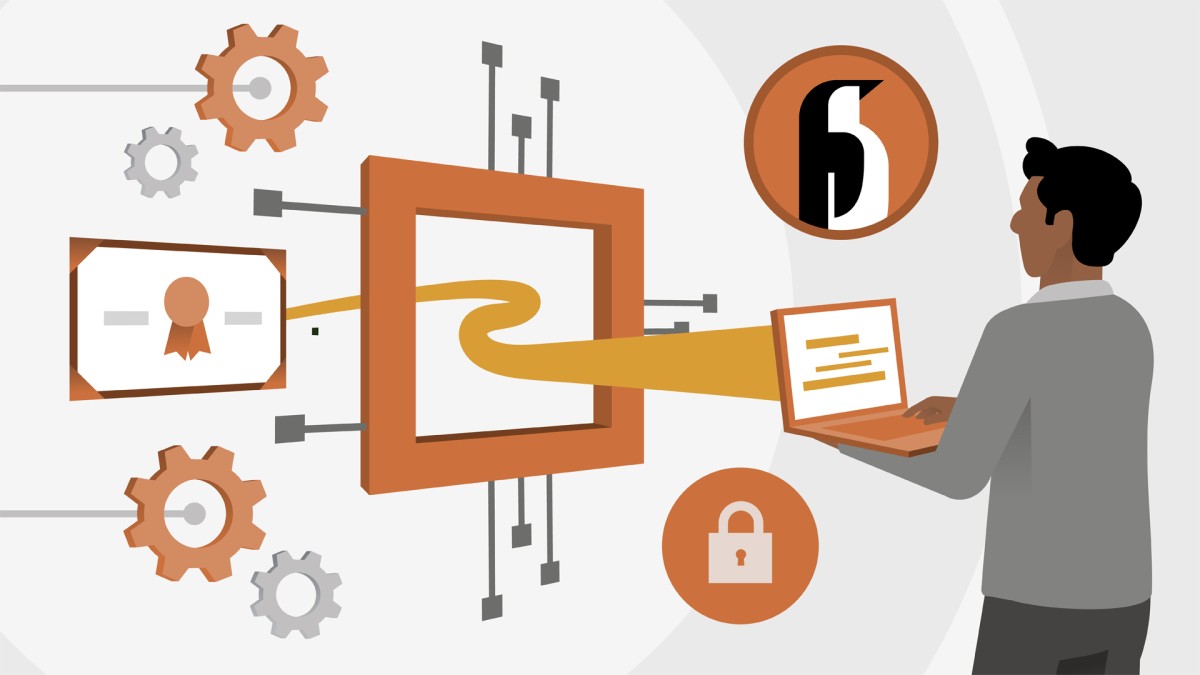مدرس
Grant McWilliams
انتشار
2023/05/19
بهروزرسانی
2024/06/24
مدت زمان
12h 50m
سطح
مناسب همه
فایل تمرینی
دارد
آموزش CompTIA Linux+ (XK0-005) Cert Prep
در این دوره، Grant McWilliams به شما کمک می کند تا برای آزمون گواهینامه CompTIA Linux+ (XKO-005) آماده شوید. Grant به موضوعات کلیدی تحت پوشش در آزمون XKO-005 می پردازد، از جمله راه اندازی، پیکربندی، مدیریت فایل، نگهداری سرور، امنیت و عیب یابی.
Introduction
Prepare for the CompTIA Linux+ XKO-005 Certification
()
What you should know
()
About the Linux+ XKO-005 exam
()
1. Lab Setup
Explore Linux distributions
()
Prepare the host for virtualization
()
Enterprise Linux install
()
Ubuntu install
()
Locale and date tools
()
2. Manipulating Files
About Linux Shells
()
About Linux Terminals
()
Get help on the command line
()
Understand the Linux Filesystem Hierarchy
()
Understand filesystem paths
()
Create files and dirs
()
Get information about files
()
Copy files and dirs
()
Move and rename files and dirs
()
Remove files and dirs
()
Create links to files and dirs
()
Use input-output redirection (>, >>, |, 2>)
()
Connect programs with named and unnamed pipes
()
File redirects and tees
()
Find files using Locate
()
Find files with Find
()
3. Processing Text Files
Get familiar with Nano
()
An introduction to Vim
()
Edit text in Vim
()
Find text in files with grep
()
Edit text with sed
()
4. Basic Boot Process
Understand the Linux bootup process
()
Linux boot loaders and sources
()
Use GRUB2 commands
()
Rescue a system
()
5. Maintaining Processes and System Services
About Linux processes
()
Monitor processes using ps
()
Monitor processes in real time
()
Manage processes
()
Manage process jobs
()
Introduction to systemd services
()
Get systemd service status
()
Manage systemd services
()
Make systemd services persistent
()
Introduction to job scheduling
()
One-time jobs using at and batch
()
About cronjobs
()
Systemd timers
()
Analyze system processes and optimize
()
Troubleshoot applications and hardware
()
6. Configuring Network Connections
Linux networking overview
()
Prepare for Linux networking
()
Configure live network connections
()
Configure saved network connections
()
Configure networking with NetworkManager
()
Troubleshoot DNS client issues
()
Monitor the network and remediate
()
7. Managing Users
User and group overview
()
User account file
()
User password file
()
Group accounts and passwords
()
Create and delete users
()
Modify user accounts
()
Create and delete groups
()
Assign users to groups
()
Become a super user
()
Elevate group privileges
()
Elevate privileges using sudo
()
Manage sudo users
()
8. Handling Storage
Linux storage system overview
()
Prepare for handling storage
()
Create partitions using fdisk
()
Create partitions using parted
()
Manage LVM volumes and volume groups
()
Expand existing logical volumes
()
Reduce existing logical volumes
()
Create EXT filesystems
()
Repair EXT filesystems
()
Create and repair XFS filesystems
()
MDRAID or DMRAID?
()
Create a RAID 5 using LVM
()
Create RAIDs using mdadm
()
Mount filesystems on boot
()
Encrypt drives with LUKS
()
Troubleshoot storage systems
()
9. Backup, Restore, and Compress Files
Archive files with tar and cpio
()
Compress files
()
Copy files between systems
()
10. Manage Software
Software management systems overview
()
DNF overview
()
Get DNF packages by name
()
Get info on packages with DNF
()
Get info on package groups with DNF
()
Search for packages with DNF
()
Install and remove packages with DNF
()
Install and remove package groups with DNF
()
Get package information with RPM
()
Manage DNF repositories
()
Manage OS updates
()
Update the kernel
()
Manage kernel modules
()
Get package information with dpkg and APT
()
Manage software with dpkg and APT
()
Work with APT repositories
()
Install software from source
()
About sandboxed applications
()
11. File Security
What is a file?
()
Get information about files
()
About extended attributes
()
Get extended attributes
()
Linux permissions overview
()
File and directory modes
()
File ownership
()
Permissions using numeric method
()
Permissions using symbolic method
()
Initial permissions using umask
()
Special file bits: SUID and SGID
()
Special directory bits: SGID and Sticky
()
Access control lists overview
()
Read access control lists
()
Set access control lists
()
Configure inheritance with default access control lists
()
Delete access control lists
()
Troubleshoot access control
()
12. Mandatory Access Control
Set enforcing and permissive modes for SELinux
()
List and identify SELinux file and process context
()
Restore SELinux default file contexts
()
Use booleans to modify SELinux behavior
()
Diagnose routine SELinux policy violations
()
Maintain security context when managing files
()
Use AppArmor
()
13. System Security
About pluggable authentication modules
()
Use login counters
()
Change default password policies
()
Edit global user account defaults
()
Lock user accounts and change password aging
()
Force password resets
()
Configure Secure Shell
()
Explore PKI concepts
()
Configure key-based authentication for SSH
()
Tunnel data with SSH
()
Summarize security best practices
()
14. Linux Firewalls
Compare and contrast Linux firewalls
()
Use firewalld for packet filtering
()
Use firewalld zones
()
Use firewalld for NAT
()
15. Automation and Scripting
What makes a shell script a shell script?
()
Positional arguments
()
File globbing
()
Wildcards
()
Bash variable scope
()
Output to STDOUT and STDERR
()
Pipe data into a script
()
Conditional flow with if, then if
()
Conditional flow with case
()
Numeric conditions
()
String conditions
()
File conditions
()
For loop
()
While loop
()
16. Automating Jobs
Manage one-time jobs with at
()
Manage reoccurring user jobs with cron
()
Manage reoccurring system jobs with cron
()
Configure a system to use Network Time Protocol
()
17. Version Control
Start with Git
()
Commit and add files
()
Why branch?
()
Create branches
()
Compare, rename, and delete branches
()
Merge branches
()
Create a GitHub repository
()
18. Realizing Virtual and Cloud Environments
Compare cloud and virtualization concepts
()
Types of hypervisors
()
VM initialization and tools
()
Explore containers
()
19. System Orchestration
Utilize configuration management systems
()
Explain server roles
()
Infrastructure and build automation
()
About app deployment
()
Explore orchestration
()
Conclusion
Take the exam
()
Ex_Files_Cert_Prep_CompTIA_Linux_XK0_005.zip
(764 KB)
دانلود فایل فشرده
با توجه به امکانات آموزش و همچنین امکانات بسته انتخاب شده لینک دانلود فایل فشرده آماده خواهد شد. با در نظر داشتن این شرایط لطفا بسته مورد نظر خود را انتخاب کرده و روی دکمه درخواست لینک دانلود کلیک کنید
در حال به روزرسانی اطلاعات
درخواست لینک دانلود
در حال به روزرسانی اطلاعات
لطفا قبل از فعالسازی لینک دانلود به موارد زیر توجه کنید:
- پسورد فایلهای فشرده است.
- لینکهای آماده شده تا 8 روز پس از فعالسازی منقضی خواهند شد.
- حجم فایلها تخمینی هستند.
- در صورتی که لینک دانلود تا 15دقیقه پس از درخواست آماده نشد، از بخش پشتیبانی پیگیری نمایید.
محتواها
179 محتوای ویدئویی
زیرنویس
English و فارسی-ماشین
کیفیت ویدئوها
1080p و 720p
فایل تمرینی
دارد
آزمون
169 سوال
آموزش های مرتبط

4h 48m
•
2023
